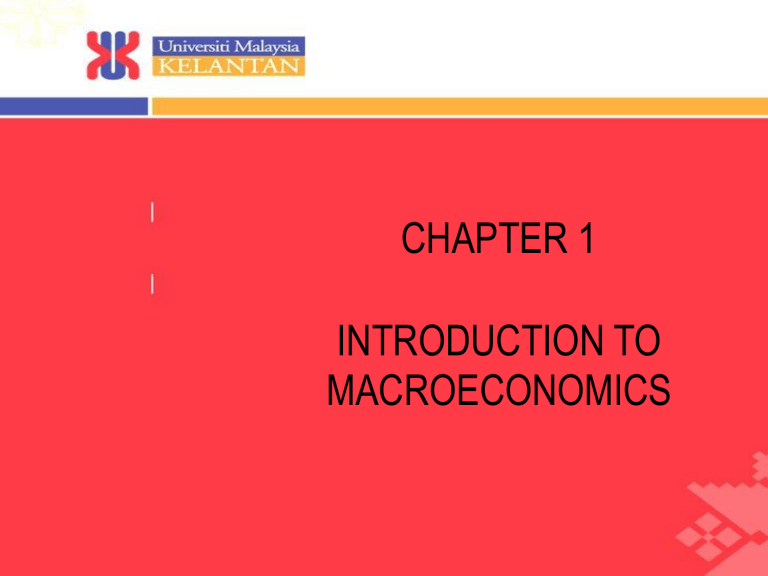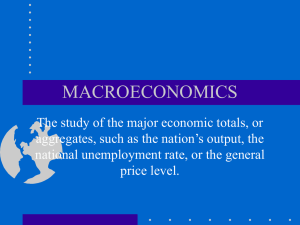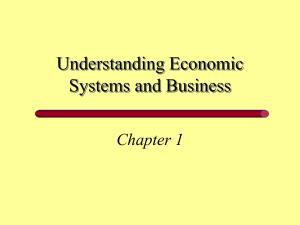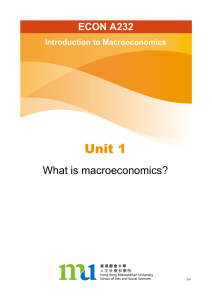CHAPTER 1

CHAPTER 1
INTRODUCTION TO
MACROECONOMICS
Introduction to Macroeconomics
• The difference between microeconomics and macroeconomics.
• Issues related to macroeconomics (output growth, unemployment, inflation and deflation)
• Public policies in solving macroeconomic problems.
Microeconomics: examines the functioning of individual industries and the behavior of individual decision making units – firms and households
Macroeconomics: the study of how the whole economy works.
Macroeconomics deals with aggregates such as aggregate C and I, and looks at the overall level of prices instead of individual prices.
Economic issues:
Current issues
Economic growth (Gross Domestic Product = National Income) / reducing the unemployment rate.
Deflation and unemployment
Control inflation and price stability
General price level (CPI) – a measure of inflation
Public policies to reduce certain problems in the economy
External Economy: (X & M)
• Public policies & Tools to reduce economic problems.
– Fiscal policy: deals with government spending, G and taxes, T
– Monetary policy: deals with money supply (Ms) and bank rate (r).
– Direct controls: focus directly on the cause of the problem – controlling prices by setting controlled items, controlling wages, increasing AS by improving the productivity, giving subsidies.
– International trade policy: related to exports (X) and imports (M)
• control foreign exchange for balance trade stability.
Macroeconomic objectives:
1.Full employment or reducing the unemployment rate.
Unemployment rate = the % of people in the labor force who are without jobs and are actively seeking jobs.
Full employment does not mean that 100 per cent of the labour force is employed. This is because there are always some people who are voluntarily unemployed as a result of being unsatisfied with their current job and resigning to find another job.
2. Control inflation or maintaining price
The objective of the nation is to keep its inflation rate as low as possible.
inflation = an increase in the general price level in the economy. Inflation will reduce the value of money or the purchasing power of money.
The quantity of goods and services purchased will be less if inflation is high.
3. Achieving a steady rate of economic growth:
rate of economic growth = the % increase in the real output over a 12 month period.
In a business cycle, economic growth is measured by the aggregate output and the unemployment rate. There are four phases in a business cycle : peak, recession, trough and recovery.
Economic growth is also measured by evaluating the full production output per capita. If the growth rate of output is greater than the growth rate of the population, it shows an increase in the amount of goods and services produced per person. Therefore, on average, people would be better off.
4. Better quality of life
an increase in the amount of goods and services as well as a better living environment (less pollution, more green, less flood, less crime).
5. A balance in the balance of payment
to maintain the external value of the country’s currency and economic stability.
A country will try to get an overall surplus balance of payment. If we have deficit, this means that the country will have to borrow from abroad or attract deposits from abroad. This paying high interest rate and increasing country’s debt.
“ Success is no accident, it is hard work, perseverance, learning, studying, sacrifice and most of all, love of what you are doing.”
― Pele








